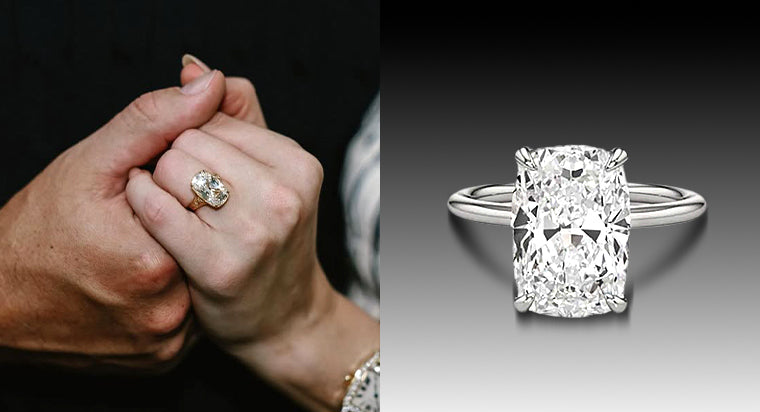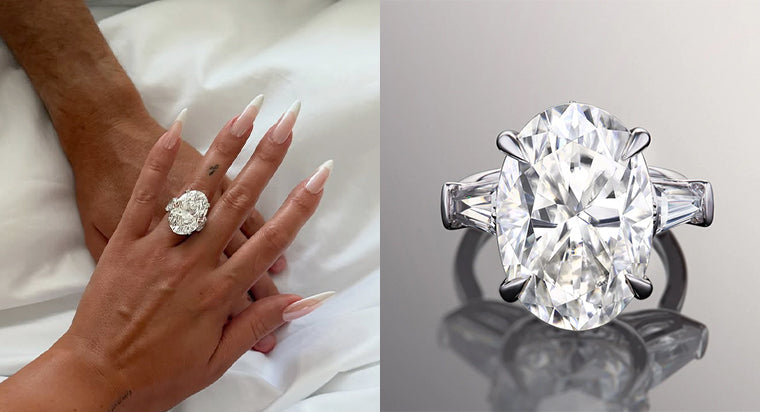Engagement Ring Prong Guide

Prong settings are the most common way to mount an engagement ring because they ensure further support for the stone, but prongs can come in a multitude of styles and numbers depending on the ring. Prongs are the thin pieces of metal that bend to attach and secure the stone that are seemingly unnoticeable in the ring as a whole.
TABLE OF CONTENTS
4 or 6-prong Rings
Since prongs are seemingly minimal in the grand scheme of things, they may be disregarded as unimportant in terms of decision-making, but that could not be falser. In fact, the prongs can make or break an engagement ring. One of the most common decisions involving prongs is the choice between four or six prongs.
4-prong engagement ring settings leave more of the gemstone exposed. This means that with four prongs, the stone will illuminate more while also appearing uninterrupted by extra metal. In addition to the added brilliance, a four-prong ring will also make a diamond appear bigger. This brilliant and bigger effect increases with less and less prongs. A 3-prong ring, for example, may appear even more brilliant than a four-prong engagement ring, but with three prong ring settings, the stone is even less secure. With this being said, a four-prong engagement ring is suggested for the maximum brilliance with the best security.
6-prong engagement rings, therefore, make the diamond appear smaller, but the extra prongs offer more support for the diamond, making it more difficult for the diamond to become loose. While a smaller diamond is clearly a con, six-prong engagement rings are perfect for round stones. Round 6-prong engagement rings offer prongs evenly distributed around the stone which gives the stone a fuller effect. 6-prong round engagement rings do not give the angular effect on the stone that a, say, 4-prong setting might. Square stones, on the other hand, are more suited for the 4-prong setting engagement rings.
Key Differences for 4-6 Prongs
Maintenance for the two settings differs as well. A 6-prong solitaire engagement ring will be much harder to clean than a 4-prong setting of a similar engagement ring. Generally speaking, the more prongs on a ring, the harder it is to clean because ultimately, there are more crevices where dirt and grime can get caught.
Safety is a big function of the prong setting, however. Therefore, it is important to note that the number of ring prongs have a direct effect on the security of the stone. A buyer of a 6-prong engagement ring is much less likely to lose a stone than a buyer of a 4-prong engagement ring. Additionally, with more surface area of the stone covered by more prongs, the diamond is further protected from accidental damage. If the wearer were to knock the ring into something, a 6-prong setting is much more likely to protect the diamond than a 4-prong setting would be.

Prong Metal Choices
There is no right or wrong answer to how many prongs a buyer should have, but there are pros and cons to both the 6-prong and the 4-prong settings. Therefore, a buyer should consider whether the security of the stone is more important or the appearance of the stone is more important.
Prongs also differ in metal choices. White gold is incredibly popular (despite the color of the rest of the band) for prongs in diamond engagement rings. This metal is white which gives the diamond a clearer color, whereas a yellow gold may make the diamond appear yellowish. Additionally, white gold is more durable than other types of gold because of its mixture with yellow gold. Therefore, white gold is a more appropriate choice for the prongs of a ring.
Platinum, on the other hand, is even more durable than white gold because of its purity of the metal. Also, white gold may wear down over time, but platinum's color does not change as the metal wears. Because of its obvious benefits, however, platinum also costs significantly more than white gold.
While white gold is more likely to break due to a multitude of situations, such as exposure to chemicals like chlorine or normal wear and tear, platinum is more likely to bend. With this being said, both prong types can become damaged, but the damage simply occurs in different manners. While it is true that platinum keeps its color, it is also much more susceptible to scratching than white gold is, and therefore, platinum may appear less shiny over the years.
Tips for Prong Options
The biggest tips for buyers considering different prong options is to think about their everyday lifestyle. It is much more important to find a ring that is added seamlessly than a ring that is beautiful but requires special treatment. Whether the buyers choose a claw prong engagement ring, a heart prong engagement ring, a high prong engagement ring, or a shared prong engagement ring, they still have to consider the choice of metal and the number of prongs in order to find a ring that is perfect for them.









